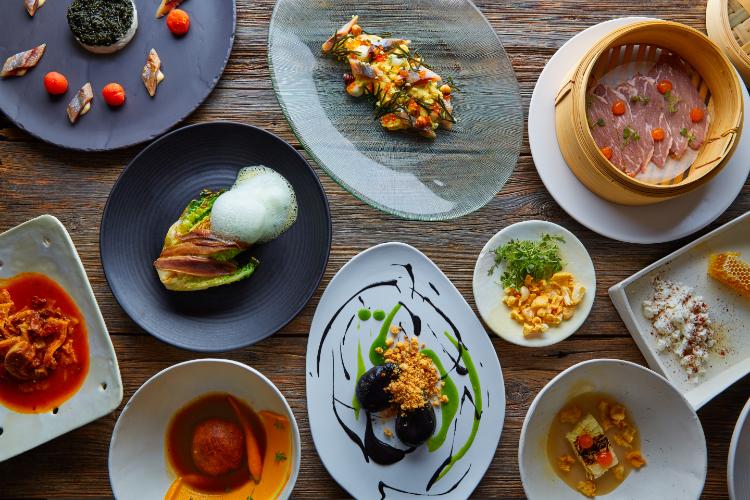107 Food Sub Niche Ideas (Beginners Have to Try)

Ready to share your knowledge of food with others?
Choosing the right food niche is the first step to success.
In this article, I explore 100+ food niche ideas perfect for beginners and experienced content creators alike.
These ideas will make choosing the area to sink your teeth into a piece of cake (puns definitely intended).
And for even more ideas, check out my lists of personal finance sub niches, travel sub niches, and low-cost business ideas to inspire your next project.
What Are The Best Food Niche Ideas?
Here are the best food niche ideas.
Regional Cuisine Specialties
Love exploring regional cuisine specialties? This section is for you:
- Southern American Soul Food: Show your audience how Southern cuisine can’t go without fried chicken, collard greens, and indulgent mac and cheese. There’s so much to share about these comfort food classics.
- Spanish Tapas and Pintxos: Teach your followers about small plates for sharing and savoring between sips of wine or sherry. Explore the rich tapas culture with your audience.
- Hawaiian Poke Bowls: Introduce your viewers to the allure of Hawaii’s quintessential poke bowls, bursting with fresh, bright island flavors. Share recipes for these deceptively simple yet flavorful dishes.
- Brazilian Churrasco: Help your audience experience the Rodizio-style parade of endlessly sliced grilled meats. Explain what makes this Brazilian barbecue tradition so special.
- Oaxacan Mexican Specialties: Guide your followers through the complex, layered moles and crispy tlayuda tostadas topped with chapuline grasshoppers. Showcase how this cuisine remains deeply rooted in pre-Hispanic traditions.
- Cantonese Dim Sum: Educate your audience about those bamboo steamer baskets parading around the dining room during dim sum time. Describe these Cantonese specialties and their cultural significance.
- Moroccan Tagines: Teach your viewers about the allure of Morocco’s signature stew, with warm spices slowly perfuming the air. Explain the significance of the tagine’s conical lid and its role in flavor development.
- Polish Pierogi and Kielbasa: Introduce your audience to the comfort of pillowy potato and cheese-filled pierogi dumplings. Share recipes and techniques for making this Polish soul food at its finest.
- Peruvian Ceviche and Causas: Explain to your followers how Japan’s influence on Peru’s Pacific-facing cuisine resulted in iconic dishes like ceviche. Explore the unique flavors and preparation methods of Peruvian cuisine.
- Cajun and Creole Cuisine: Guide your audience through the flavors of Louisiana, from jambalaya’s party of rice and protein to velvety shrimp étouffée. Highlight the differences between Cajun and Creole cooking styles.
- Balinese Specialties: Awaken your audience’s senses with Bali’s fragrant and intricate specialties. Teach them about crispy, juicy babi guling suckling pig and sublime bebek betutu smoked duck.
- Turkish Meze and Kebabs: Show your followers how to graze their way through a stunning array of small meze plates like tangy ezme salads and creamy hummus dips. Pair these with lessons on preparing various kebab styles.
- Argentine Asados: Educate your audience on how an asado is more than just a grill-out – it’s an Argentine cultural experience. Teach them about wood-fired meats like juicy chorizo sausages and tender bife de chorizo steaks slathered in zingy chimichurri.
- Tuscan Cucina Povera: Introduce your viewers to rustic, peasant-style dishes crafted from humble ingredients like local game, vegetables, and day-old bread. Share the history and techniques behind this resourceful cooking style.
- Szechuan Spicy Cuisine: Prepare your audience for the iconic tingling, mouth-numbing intensity of Szechuan peppercorns. Teach them how to balance and appreciate the bold flavors of this regional Chinese cuisine.
- Austrian Kaffeehaus Culture: Transport your followers to opulent Viennese cafes, sharing recipes for rich sachetorte chocolate cake and frothy cafe melange drinks. Explain the cultural significance of these daily indulgences.
- Nepalese Dals and Momos: Guide your audience through hearty, lentil-based dals like Nepali classics Masako and Kahlo dal. Teach them how to make steaming hot momos, Nepal’s version of dumplings reflecting Tibetan and Indian influences.
- Lebanese Mezze Platters: Show your viewers how to build their own stunning array of small mezze plates like smoky baba ghanoush, bright tabbouleh, and creamy hummus.
- Québécois Poutine and Tourtière: Introduce your audience to the comfort of crispy fries smothered in hot gravy and squeaky cheese curds on a frigid Québec winter day. Pair your poutine lessons with tutorials on making hearty baked tourtière meat pies.
- Singaporean Laksa and Satay: Teach your followers about Singapore’s culinary influences through coconut milk-enriched laksa noodle soups and grilled satay skewers with spicy peanut dipping sauce.
- Puerto Rican Mofongo and Lechon: Guide your audience through making the signature Puerto Rican dish of bright green, garlicky mofongo. Pair it with lessons on preparing crispy lechon skin from whole spit-roasted suckling pig for the ultimate Spanish Caribbean indulgence.
- Nigerian Jollof Rice and Suya: Introduce your viewers to the vibrantly spiced, tomato-stained jollof rice, an iconic West African dish.
Dietary Restrictions and Allergies

Show your readers how to whip up tasty meals that cater to various dietary needs and allergies:
- Gluten-Free Baking: Guide your audience through gluten-free baked goods using alternative flours like almond or oat paired with essential binders. Share tips for achieving the right texture and flavor without gluten.
- Dairy-Free Desserts: Teach your followers to satisfy their sweet tooth sans dairy with creamy, lush desserts using plant-based milk alternatives. Explore innovative ways to replicate traditional dairy-based treats.
- Egg-Free Breakfast Ideas: Show your audience how veggies can steal the show for savory, protein-packed, egg-free breakfasts. Demonstrate techniques for creating tofu scrambles and veggie-packed frittatas without eggs.
- Nut-Free Baked Goods: Educate your viewers on how to ditch nut butter and pack baked goods with equally rich alternatives like sunflower seed butter and coconut butter. Provide recipes for nut-free granola bars, cookies, and more.
- Soy-Free Vegetarian/Vegan: Guide your audience through going plant-based without soy, using protein sources like lentils, quinoa, and seeds. Teach them how to recreate their favorite Asian-inspired and meat-analog recipes soy-free.
- Paleo-Friendly Treats: Show your followers how to indulge their Paleo sweet tooth with desserts using nut flours/butters and natural sweeteners. Demonstrate how to create treats minus any grains, dairy, or refined sugars.
- Low FODMAP Recipes: Help your audience care for their gut health with low FODMAP recipes that limit fermentable carbs that trigger IBS issues. Provide ready-to-go meal plans and shopping lists to take the guesswork out.
- Keto-Friendly Bread Alternatives: Teach your viewers to stay in ketosis with high-fat, low-carb “bread” made from nut and seed flour. Show them how these swaps deliver that bread fix in a keto-approved package.
- Vegan Cheese Alternatives: Help your audience forget dairy and get their cheesy fix from nut-based aged “cheeses” or creamy coconut milk varieties. Demonstrate techniques for creating convincing vegan cheese flavors and textures.
- Grain-Free Crackers and Snacks: Show your followers how to ditch high-carb grains for savory veggie-based snacks and crackers. Teach them how to deliver crunch and flavor minus the usual allergens.
- Refined Sugar-Free Desserts: Educate your viewers on satisfying their sweet tooth the healthy way with treats free of processed sugars. Instead, use natural sweeteners like fruit, maple syrup, or monk fruit.
- Coconut-Free Vegan Recipes: Guide your audience to vegan recipes catering to coconut allergies and intolerances. Show them how to use alternate plant-based milk and fat sources like cashew, oat, or sunflower.
- Mushroom-Free Vegetarian: Teach your followers to achieve umami richness without mushrooms in vegetarian dishes. Demonstrate using alternatives like nutritional yeast, miso, soy sauce, and smoked seasonings for hearty, satisfying mushroom-less meals.
- Yeast-Free Bread Alternatives: Explain how baking soda recipes for delicious flatbreads, crackers, and quick bread are perfect for candida diets or yeast allergies.
- Fish and Shellfish-Free Recipes: Guide vegetarians and those with seafood allergies through dishes mimicking briny, ocean-like flavors.
- Migraine-Friendly Meal Plans: Provide your viewers with pre-planned meals that avoid common trigger foods like aged cheeses, cured meats, and red wine. Teach them how to create flavorful dishes while avoiding migraine triggers.
- Air-Fryer Allergy-Friendly Snacks: Show your audience how to make crispy veggie fries and chips, “chicken” nuggets, and more safely at home without cross-contamination risks. Demonstrate allergy-friendly air fryer techniques and recipes.
- Low Histamine Diet Recipes: Guide your followers through recipes perfect for histamine intolerances. Teach them to emphasize fresh ingredients while avoiding fermented, cured, or smoked foods that are histamine triggers.
- FPIES Safe Foods: Educate your audience on gentle purees and stage-based recipes tailored for pediatric food protein allergies. Demonstrate how to create easily digestible yet nutrient-dense introductions for FPIES management.
- High Protein Vegetarian Meals: Show your viewers how to create power bowls, patties, and more vegetarian protein-packed dishes.
- Low Oxalate Recipes: Demonstrate limiting high oxalate ingredients like spinach, nuts, and soy while embracing oxalate-friendly alternatives.
- Diabetes-Friendly Dessert Remakes: Guide your viewers through enjoying remade classics sweetened with natural alternatives like monk fruit. Show them how to create portion-controlled desserts for diabetes patients, with added nutrient boosts.
- Corn-Free Mexican Cuisine: Help your audience get their Mexican food fix without corn. To accommodate corn allergies, use corn-free tortillas and chip alternatives like cassava, jicama, or plantains.
- Oral Allergy Syndrome Treats: Educate your followers on creating treats for those whose pollen allergies cross-react with raw fruits and veggies.
Sustainable and Eco-Friendly Eating
Help your followers embrace sustainable eating habits that benefit both their health and the planet:
- Plant-Based Meat Alternatives: Guide your audience through the fascinating science of meat alternatives made from plant proteins. Demonstrate how to replicate the taste and texture of meat with a vastly reduced environmental footprint.
- Urban Gardening and Hyperlocal: Teach your viewers tips for micro-gardening, joining community gardens and CSAs, and reducing produce transportation miles.
- Zero-Waste Cooking: Educate your audience on recipes and practices that ensure using every last edible bit of ingredients. Demonstrate smart planning, repurposing scraps, composting, and more to eliminate food waste.
- Foraging for Wild Edibles: Guide your followers in reconnecting with nature’s bounty through safe identification and responsible harvesting of wild plants, berries, herbs, and mushrooms. Show them how to incorporate these finds into unique foraged dishes.
- Backyard Homesteading: Teach your audience to turn their outdoor space into a sustainable mini-farm.
- Greenhouse Growing Year-Round: Show your viewers how to extend their harvests year-round with greenhouse growing using hydroponic or aquaponic systems.
- Preserving the Harvest: Guide your audience through techniques like canning, dehydrating, freezing, and fermenting to capture the bounty for later enjoyment. Teach them how to handle garden overflow efficiently.
- Low-Waste Packaging Alternatives: Educate your followers on cutting back on single-use packaging by buying in bulk, reusing containers, and making snacks and mixes at home.
- Farmer’s Market Meal Planning: Show your audience how to center their meals around locally-grown, seasonal produce at its peak ripeness and nutritional value.
- DIY Pantry Staples: Teach your viewers how to make their own nut milks, butters, fermented foods like yogurt and kombucha, and whole grain flours right at home. Then, demonstrate how to avoid processed products with homemade alternatives.
- Meatless Protein Sources: Provide complete nutritional profiles and delicious recipes for different protein sources.
- Rainwater Harvesting: Show your followers how to sustainably save water (and money!) by collecting roof runoff and storing it in tanks or barrels.
- Nose-to-Tail Eating: Educate your audience on the ethical approach to minimizing waste by consuming all parts of an animal.
- Ugly Produce Specials: Teach your viewers how to find and use “ugly” fruits and veggies discarded for minor blemishes.
- Backyard Composting: Guide your audience in turning household scraps, yard waste, and other waste into nutrient-rich soil amendments.
- Regenerative Agriculture: Educate your followers on the principles of this holistic farming approach. Show them how no-till methods, cover cropping, and focused soil management can rebuild environmental health.
- Farm-to-Table Restaurants: Introduce your audience to innovators committed to ultra-local sourcing with on-site farms or gardens. Showcase how these restaurants create seasonal, sustainable cuisine based on what’s growing nearby.
- Heirloom Variety Revivals: Teach your viewers how to cherish biodiversity by growing out unique, older, open-pollinated cultivars of plants. Guide them in exploring the rich culinary heritage of heirloom varieties.
- Edible Landscaping: Show your audience how ornamental gardening meets permaculture. Guide people on seamlessly incorporating edible plants into ornamental landscapes for beauty and function.
- Low-Impact Seafood Choices: Educate your followers on sustainable wild-caught and aquaculture seafood options.
- Solar Cooking and Ovens: Help your audience embrace the sun’s natural power with homemade solar cookers and ovens.
- Low-Food Mile Challenge: Inspire your viewers with tales of aiming to source all food within hyper-local radiuses of just miles.
- Natural Dyeing with Food: Show your audience how common kitchen items like onion skins and turmeric can create beautiful, non-toxic fabric dyes.
- Silkworm Farming and Products: Introduce your followers to the art of sericulture and teach them how to raise silkworms sustainably for their fiber and frass fertilizer using traditional methods.
Fusion and Experimental Cooking

Challenge your readers to mix things up in the kitchen with some fusion and experimental cooking techniques:
- Asian-Mexican Fusion: Show your audience how to create a delectable melting pot where the heat of chilies meets the aromatic punch of curries, all wrapped up in a tortilla. Molecular Gastronomy Techniques: Teach your viewers to use techniques like spherification, foams, and powders to dazzle the senses.
- Fundamental Flavor Blending: Guide your audience through deconstructing and building flavors from the ground up. Show them how to use isolation tanks, aroma capturing, and distillation to tease out the purest essence of ingredients.
- Dessert Reinventions: Help your followers create out-of-the-box desserts that playfully merge sweet and savory worlds.
- Deep-Fried Global Mash-Ups: Teach your viewers how to combine humble state fair techniques with worldly street foods.
- Charcoal Grilling and Smoking: Demonstrate activated charcoal in rubs and brines or unleashing the powers of unusual smoking wood fuel sources for velvety, seductive notes.
- Fermenting with Unique Cultures: Show your followers how to gather wild microbes and starters from around the globe.
- Edible Insect Protein: Help people break through cultural barriers and explore the sustainable future of protein-packed entomophagy. Guide them from using cricket flour to preparing whole grilled insect delicacies.
- Classical French-Sushi Fusions: Demonstrate to your viewers how to deconstruct the rich flavors of French cuisine and reinterpret them as sushi.
- Centrifugal Cooking and Herbs: Teach your audience how to extract and isolate the purest herbal waters and essences through centrifugal forces.
- Middle Eastern-Scandinavian: Introduce your followers to an unexpected flavor mash-up. Show them how to harmonize the warmth of za’atar with bracing aquavits, pickling traditions, and spice-embracing cuisines of the far north.
- Industrial Technique Adaptations: Guide your viewers in unleashing wild flavors by hacking tools like dehydrators, freeze dryers, and rapid infusers. Demonstrate techniques for extractions and concentration of ingredients.
- African Piri-Piri Portuguese: Show your audience how formerly colonial ingredients meet in a sizzling union. Teach them to combine fierce piri-piri pepper sauces with smoked chorizo and roasted chicken.
- Chiles and Chocolate Desserts: Help your followers explore the bewitching alchemy of spice and sweetness. For example, demonstrate folding richly spiced mole, ancho, and guajillo chiles into decadent dark, milk, and white chocolate confections.
- Deconstructed Classic Cocktails: Guide your viewers in shaking cocktails entirely free of their traditional formats.
- Australian Indigenous Fusions: Teach your audience how to rediscover ancient native foods and ingredients. Demonstrate reviving ingredients like wattleseed and lemon myrtle in partnership with European colonial cooking techniques.
- Café Chemistry Techniques: Show your followers how to push coffee and tea into the culinary avant-garde. Guide them through techniques like cold brew clarification and filtration or creating centrifuged nut milk foams.
- Woodfired Baked Veggie “Meat”: Demonstrate how to use fervent heat from wood fires and smoke to conjure deeply umami-rich, chargrilled, and smoky flavors.
- Plant-Based Charcuterie: Teach your viewers to savor cured and smoked delicacies like mushroom “salami” or create vegetable charcuterie boards. Guide them in exploring the funky, fermented side of plant-based eating.
- Medieval Cooking Revivals: Demonstrate how to use historical spice blends, open-fire techniques, cast iron cookery, and forgotten game meats and grains.
- Artistic Culinary Landscaping: Show your followers how food meets environmental art. Guide them in creating edible landscapes designed with ingredients as living garnishes, sculpted assemblages, and planted centerpieces.
- Southeast Asian-South American: Lead your audience on a cross-continental culinary exploration. Teach them to blend Southeast Asia’s bright curries and seafood with the tropical flair of South American peppers, lemongrass, coconut, and cassava.
- Yeasted Dessert Kapitals: Demonstrate how fermentation meets sweets in this inventive intersection. Guide your viewers in creating yeasted desserts spanning sweet sourdoughs, beer, and wine-infused treats, and laminated pastry hybrids.
- High-Altitude Andean Entertaining: Help your audience embrace the challenges of cooking at elevation. Show them how to work with Indigenous Andean tubers, understand unique high-altitude baking chemistry, and create local cocina craft cocktails.
- Culinary Cosmos Gastronomy: Guide your viewers to gaze into the future of interstellar dining.
Meal Prep and Convenience Foods
Offer tips on simplifying life with convenient meal prep ideas that save time without sacrificing flavor:
- Make-Ahead Freezer Meals: Guide your audience in batch cooking to stock their freezer with a month’s worth of ready-to-reheat, portion-controlled meals.
- Healthy Meal Prep Bowls: Teach your viewers how to build balanced bowls with perfect macronutrient ratios. Show them how to mix and match proteins, veggies, and grains using meal prep containers to control portions.
- Air Fryer Meal Preps: Demonstrate how to prep a week of quick proteins, snacks, and meals designed for the air fryer’s crispy, oil-free magic. Provide tricks for easy reheating and portability.
- Slow Cooker Dump Meals: Show your audience the ultimate convenience of dumping ingredients into the slow cooker for hands-off, intensely flavorful meals.
- Pressure Cooker Fast Meals: Guide your followers in using the power of pressure to create delicious one-pot meals in under an hour.
- No-Cook Meal Preps: Teach your audience to beat the heat with refreshing, no-cook salads, bowls, and cold protein mains like tuna. Provide tricks to keep these meals fresh all week.
- Mason Jar Salad Strategies: Demonstrate strategically packing mason jars with fresh salad ingredients.
- Snack Prep and Packing: Show your viewers how to bake a week’s supply of fresh snacks, such as energy bites and trail mixes, in portions for grab-and-go nibbling.
- Weekly Soup and Stew Preps: Guide your audience in batch-cooking big pots of hearty soups and stews to portion out into individual servings for the fridge or freezer. Share tips for freezing and reheating without losing flavor or texture.
- 5-Ingredient Meal Preps: Show people how to add desired flavor boosts to create variety with minimal ingredients.
- Mug Meal and Dessert Preps: Show your audience how to create single-serving, no-bake recipes for sweet treats and savory snacks. Demonstrate these perfect solutions for dorm rooms or offices.
- Food Dehydrator Meal Preps: Teach your viewers how to dehydrate proteins into portable jerkies and fruit/veggie crisps for shelf-stable snacking.
- Bento Box Packed Lunches: Guide your audience in creating nutritionally balanced, bento-style lunches with organized compartments.
- Camping/Backpacking Foods: Show your followers how to prepare calorie-dense, lightweight recipes made for the trail.
- High Protein Vegetarian Preps: Demonstrate how people can get their plant-based protein fix through meal preps starring beans, lentils, soy ingredients, and other meatless muscle-builders.
- One-Dish Oven Meal Preps: Guide your viewers in preparing full meals – protein plus sides – on a single sheet pan for easy oven-baked batch cooking.
- Budget-Friendly Meal Preps: Teach your audience to create delicious, filling meals for $5 or less per serving.
- Low-Carb Keto Meal Preps: Show your followers how to maintain high-fat ratios and moderate protein in their keto preps. Include tutorials on making portable fat bomb snacks ahead of time.
- Global Cuisine Meal Preps: Guide your audience through ethnic meal preps featuring international pantry sauces and flavors..
- Microwave Mug Dessert Preps: Show your viewers how to enjoy fresh, portion-controlled mug desserts with minimal mess or fuss.
- Freezer Smoothie Pack Preps: Show your followers how to blend up grab-and-go smoothies by batch-prepping frozen fruit/veggie packs with nutrient boosters and extras. Demonstrate how to create a variety of flavor combinations.
- 30-Minute Meal Prep Dinners: Guide your viewers through streamlined fresh meals ready in a half hour or less.
- Rotisserie Chicken Remakes: Teach your audience how to transform a basic rotisserie chicken into multiple creative, portioned remix meals. Demonstrate how to repurpose the leftovers efficiently and deliciously.
- Refrigerator Oatmeal Packs: Show your followers how to prep a week’s worth of protein-rich overnight oat cups layered with nut butters, fruits, and more. Then, guide them in creating grab-and-go breakfasts with endless flavor variations.
What Makes A Food Niche Idea Profitable?
The food industry is vast, and the competition can be fierce.
However, some factors can help you choose the best food niche to be successful in.
Here are these main factors.
Consider Your Interests and Expertise
The foundation of a thriving food blog lies in your passion and knowledge.
Ask yourself:
- What types of cuisine or cooking techniques excite you?
- Do you have a deep understanding of certain dietary restrictions or cultural flavors?
Identifying your areas of interest and expertise will make the content creation process more enjoyable.
It will also position you as an authority in your chosen niche.
For example, if you’re an avid baker with a knack for gluten-free desserts, you could focus on developing mouthwatering recipes.
You could also share your insights on navigating the gluten-free lifestyle.
Alternatively, if you’re fascinated by your country’s diverse regional cuisines, you could showcase your culinary adventures and share recipes celebrating unique flavors.
Target The Right Person
Once you’ve determined your areas of interest and expertise, it’s time to identify your target audience.
Here are the questions to ask:
- Who are the people you want to reach with your food blog?
- Are they busy parents looking for quick and healthy meal ideas?
- Budget-conscious cooks seeking affordable yet delicious recipes?
- Are you aiming to connect with a community of food enthusiasts who share your passion for a particular cuisine or dietary preference?
Researching online communities, social media groups, and existing food blogs can provide valuable insights into your potential audience’s interests and pain points.
This information will help you tailor your content and marketing strategies to serve their needs and preferences better.
See What’s Out There (Competitors)
A certain level of competition can be a good thing.
It indicates a demand for the type of content you want to create.
The key is to find the right balance of competition.
Avoid oversaturated niches where it may be challenging to stand out.
At the same time, be wary of niches with little to no competition.
This could signal a lack of interest or potential for growth.
When you have your main niche, consider exploring sub-niches within it.
For instance, instead of focusing on vegetarian recipes in general, you could specialize in vegetarian comfort food or plant-based meal prep.
This level of specificity can help you differentiate your blog and attract a more engaged audience.
Conclusion
Remember, the food blogging world is vast, with room for many unique voices and perspectives.
You can create a thriving food blog that stands out in the crowded digital landscape by aligning your interests, expertise, and target audience.
Whether you’re drawn to the rich traditions of regional cuisines, the creativity of fusion cooking, or the conscientious approach of eco-friendly eating, there’s a niche for every aspiring food enthusiast.
It’s now time to start.
Who knows?
Your next meal could be the start of something big.
Further Reading on AdamEnfroy.com: If you’re exploring different niches, you might find niche site ideas incredibly useful.
These can help you understand what works best for your blogging journey.
For those who prefer creating content without showing their face, check out these faceless YouTube channel ideas that are perfect for introverts.
Additionally, learn how to discover profitable items to sell online with these ways to find niche products.





